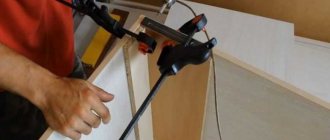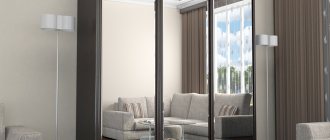Small mechanisms called door hinges for their design are responsible for the proper operation of swing doors. Their fairly simple device ensures free movement of the door during the process of opening and closing. A fully functional mechanism makes it easy to use the door leaf, without any creaks or backlash accompanying its movement. At the moment, door hinges are used both in the construction of entrance openings in buildings and in furniture. In the latter case, smaller mechanisms are used, but with similar operating principles. Do-it-yourself installation of furniture hinges may be required when you are installing new doors in a kitchen cabinet or bedroom closet yourself. Despite their small size, hinges can cause a lot of inconvenience during installation due to the need for accurate calculations of their fixation locations. Also, some work will have to be carried out in weight, which in some cases may require additional hands to help with large furniture components.
Features and types
The simplicity and functionality of the door hinge mechanism has given rise to many of its varieties, designed for use in various types of products for the home interior. Now such devices are found in the following versions:
- Invoices. Used in wardrobes and cabinets with hinged doors;
- Deposits. For small cabinets with low weight doors;
- Heel. More often used in interior doors, they can serve well in cabinets with small fronts;
- Pianos. Found in folding tables with a book design;
- Adit. Suitable for doors of false panels and fixed panels of sliding wardrobes;
- Angular. Designed for the appropriate types of compartments installed in the corners of rooms and having limited space for opening doors;
- Semi-overhead. Used in cabinets with a large number of fronts;
- Mezzanine. They are also “horizontal” hinges used in hanging cabinets in the kitchen.
The use of a particular type of door hinge in a closet depends on many factors, including its style, dimensions, weight of the doors and the method of their fastening. In some cases, due to the physical placement of the door relative to the frame, the compartment requires the use of exclusively corner hinges, which have a greater range of movement compared to traditional overhead hinges. In products with a classic texture, only such mechanisms can be used that will correspond to this style.
Kinds
Today, manufacturers offer more than ten different types of hinges for kitchen cabinets. This ranges from the simplest “frogs” to hinges with closers of various complex designs.
Different door hinges are attached differently.
- Overhead loop or frog loop.
It is a four-bar hinge mechanism. It presses the door tightly and allows you to open it 90 or 165 degrees. This type of loops is the most common. It can be found on almost any kitchen set that has swing doors. Such hinges allow you to completely cover the furniture body on which they are attached.
- Semi-invoice.
It allows you to partially cover the headset body. Its structure has a slight bend, due to which a gap is formed between the cabinet doors, fixed to one rack, which makes it possible to open both at the same time without any problems.
- Internal.
Outwardly, it is very similar to a semi-overlay. But its application is different. An internal hinge is installed when it is necessary to place the door set inside the frame.
- Inverse
. Allows you to open the cabinet door 180. In this case, the door is flush with the frame.
- Corner
. From its name it is clear that it installs doors at an angle. This is necessary for corner drawers. Standard hinges in this category come with installation angles of 175,135,90,45 and 30. But there are also non-standard corner hinges.
- Mezzanine.
Used to hang horizontally opening drawer doors. This type of hinge is based on a spring.
- Piano.
Rarely used in modern furniture due to its unreliability. It is used mainly for book tables and for attaching folding tabletops.
- Card loop.
Essentially, this is the same piano loop, only shorter. It is often used in retro-style furniture; for this purpose, these hinges are shaped or given the shape of a butterfly.
- Secret
. It has two plates, with the help of which horizontal facades that go down are attached. They got their name for their use in secretaries. Similar to a piano loop.
- Adit.
Mounted on cabinets adjacent to the wall.
- Card shop.
With their help, folding facades are attached. Such hinges have the ability to fix the cabinet door. They are attached from the end to the door and frame and allow you to open the structure 180. Card hinges are very popular on folding tables.
- Reversible loop.
Allows you to open the doors 180 degrees and return them back, like at the entrance to a supermarket.
- Heel.
Attached to the corner of the facade. It can go deep inside the sash, but is only suitable for lightweight doors. Therefore, its use is very limited.
Hinges also vary in their use in certain materials. Glass, plastic, and fiberboard require different hinges.
There are also two types of hinges that differ in installation. Slide-on are standard hinges, and clip-on are instant installation hinges. Clip-on hinges reduce installation time by up to 60% due to the collapsible hinge, which has two parts that snap together.
Another type of hinges for kitchen furniture are hinges with a driver. Their price is much higher, but it justifies itself. First of all, it's convenient. They pushed the door, and it closed further by itself. Secondly, it preserves the condition of the furniture. Since the closers themselves regulate the force of closing the door, thereby keeping both the facades and the frame itself in their original condition. Thirdly, they prevent the sound of doors slamming without irritating the nervous system.
Required materials and tools
Installing a door hinge will require disassembling the mechanism, so you will need tools to perform delicate, neat procedures. In addition, other manipulators will be required for general work with the door. A complete list of all tools for installing an overhead hinge model is as follows:
- Screwdriver with a Phillips bit.
- Set of screws.
- Building level.
- Ruler or tape measure.
- Screwdriver.
- Drill.
- Pencil or erasable marker.
- Cutter with a diameter of 35 mm.
The standard layout of a door hinge involves its disassembly into three components:
- The base is in the form of a strip, which is responsible for attaching the hinge to the cabinet panel.
- Cup, which is mounted on the working door.
- The hinge body is a moving part that connects the door to the cabinet body.
The door hinge mechanism is installed using mounting screws screwed into the holes of the mounting plate and cup. The operating parameters of the device are determined by the adjusting screw in the housing. Thus, the hinge mechanism has up to six mandatory fasteners, which are best prepared in advance as spare ones.
Adjustment
Adjustment (or adjustment) is the final stage of installation of furniture hinges. It must be performed in several planes at once - vertically, horizontally, and in relation to depth:
- Adjusting the depth will help press the door closer to the body, or ease the pressure. You need to tighten the oval hole.
- On the vertical side - it will help to move the facade. This is done by twisting oval-shaped holes.
- On the horizontal side - ensures free movement of the door back and forth and back. The purpose of this adjustment is to avoid gaps between the cabinet and the door. The method is great for rooms with uneven floors or walls.
Now you know how to secure furniture hinges. As you can see, this is not so difficult to do. You don't need to have any special skills or abilities. Doing this kind of work with your own hands will be another reason for a little pride.
Source: pro-dom-mebel.ru
Marking
Marking is an integral part of the cabinet layout for the correct installation of the door and the correct operation of its hinges. Mistakes made at this stage will, at a minimum, spoil the appearance of the product, and at maximum, make it impossible to correctly use the swing door mechanism. During the marking process, you will need a pencil or marker to mark the areas for creating holes for the cups of the mechanisms. Therefore, it’s worth starting with the main points of the markup instructions:
- Depending on the weight and size of the door leaf, the number of hinges installed can vary from two to five.
- You should not install the mechanism cup on the very edge of the door facade. It is recommended to maintain a margin of 2–2.2 cm.
- The average distance between hinges on a meter-long door leaf is at least 50 cm. In this case, you need to take into account its weight, which may require a larger number of fastening mechanisms.
Make sure that the areas for installing hinged awnings on the façade are not opposite the cabinet shelves. Otherwise, there is a risk that the door will not close completely due to the fact that the body rests on the shelf platform.
Types of hinges for furniture
For installation, overhead devices with four hinges, the so-called frogs, are most often used. Such fastenings are convenient for any design that involves hinged doors - a wardrobe or kitchen cabinet, or other types of furniture.
Metal parts are made of durable alloys that are resistant to corrosion and mechanical deformation.
Furniture hinges are divided into several types, depending on how they are attached:
- Invoices;
- Semi-overhead;
- Deposits;
- Inverse;
- Piano;
- Heel;
- Stolnye, etc.
Types of furniture hinges.
For cabinets, overhead structures with cup bases are often used, which are connected to the panel using self-tapping screws. Mechanical inserts with a “shoulder” are inserted into these bases and fixed to the door and side panel.
Such fasteners are quite reliable and durable, since they have a reinforced connection to the planes.
Depending on the type of cabinet and its dimensions, as well as the material, select the appropriate type of connecting parts. Some elements are used exclusively for classic furniture, where all details must match the style. For ordinary wardrobes, standard overhead and semi-overlay fastenings are chosen.
For installation on the doors, it is necessary to use certified industrial products - this guarantees the strength and long service life of the furniture and its individual parts.
Hole preparation
Holes are created using a drill based on the markings. An electric screwdriver with an appropriate attachment is also suitable as an alternative tool. In addition, the use of a cutter is a must, which ensures that the structural integrity of the door facade and cabinet panel is preserved. Otherwise, drilling a hole can lead to chipping and deformation of the wood panel. The insertion should be made with a depth of no more than 12 mm, which will be enough for a reliable hole for the loop cup platform. It is better to select the drilling speed yourself, based on the density of the material from which the facade and cabinet are made. While chipboard panels are fairly easy to process, natural walnut or ash are distinguished by high strength. For the same reason, you need to ensure that the drill works strictly at an angle of 90 degrees, from which it can easily deviate if you are dealing with hard natural wood.
Adjusting furniture hinges with your own hands
According to the diagram for installing furniture hinges, a mounting plate is separately attached to two 3x16 mm screws and a bowl (also to two screws), on the side of the frame and on the inside of the door, respectively. After the furniture is placed in the designated place, they begin to hang the facades. To do this, the arm of the hinge with the bowl is threaded into the fastening bar and tightened with a fixing screw. There is no need to tighten the fasteners too much near the plank - all of them are involved in the process of adjusting the furniture hinge with your own hands.
If the floors are piled towards the center, then most likely the doors will not press tightly against the frame. Adjusting the furniture hinges in depth allows you to tighten them more tightly or, conversely, loosen the pressure.
For uneven floors, lateral adjustment (horizontal) in combination with vertical adjustment may be useful. With its help, you can even out gaps on double facades and align them more evenly relative to the frame.
Also, the adjustment “removes” unpleasant squeaks when opening and closing. It is worth tightening the screws on the hinges from time to time - furniture doors inevitably sag under their own weight. Timely adjustment will extend the service life of fastening fittings.
Hinge Attachment
Due to the fact that the door leaf is a moving object, unlike the cabinet, you need to start attaching the hinge from there. This will make your work easier by eliminating the need to adjust the facade to the hinges when you have to hang it. Installation work with swing mechanisms can be carried out in accordance with the following instructions:
- At the stage of installing the door hinge, all the flaws in marking and work on the holes may appear if you first place it on the site of future installation. Try to carry out a similar check first, making sure that the platform of the overhead hinge cup fits tightly to the surface of the door leaf over its entire area. Even the slightest deviation can cause the door to warp in the future.
- Using a pencil and applying a loop, new markings are made for the screws so that they fit evenly into the grooves of the loop.
- After this, you can install the platform last by screwing in the fasteners using a screwdriver or screwdriver.
Installing hinges on cabinet doors
Now you need to attach the second part of the structure to the cabinet door. Let's consider the sequence of work.
All work should be carried out slowly and consciously in order to avoid defects and mistakes, and also not to insert a self-tapping screw into an unnecessary place, thereby ruining the facade.
Marking and drilling
Using a pencil and marker, you need to mark the places for drilling. To do this, take the second part of the device and attach it to the board. To do everything correctly, you need to place the structure on a flat surface.
Before attaching the hinges, carefully check that you have positioned the interior of the cabinet correctly.
Attach the door to the frame where part of the hinge is already attached. Mark a place for future fastening. It is better to use a corner and a level so that the loop is level, without tilting.
When installing fasteners, it is better to ask for help in order to prevent flaws.
Installation
Attach the loop to the intended location, and use a screwdriver and screws to attach the structure. It must be held firmly and pressed well against the door. Upon completion of work, check reliability. To do this, loosen the loop a little; if it holds well, then everything is fine and you can proceed to the final stage.
Here it is also necessary to be precise, otherwise the door will open with difficulty at the slightest defect.
Hanging the facade
The complexity of this stage of work lies in the need to manually hang the door leaf with installed hinges so that their bodies fall under the platforms fixed to the cabinet panel. All installation work is carried out in the following sequence:
- If possible, it is worth turning the cabinet into a horizontal position. This will simplify the process of trying on the façade for further installation.
- Using a pencil, create markings for future mounting strips into which the hinge mechanisms will be installed.
- Place the planks exactly according to the markings and secure with self-tapping screws using a screwdriver.
- Install the door on the side of the cabinet, being careful not to deviate from the marked positions for the hinges.
- You can begin to fully assemble the hinges by connecting their front and base platforms using the housing. The result is finished swing mechanisms, ready for work.
- At the last stage, you will need to adjust the hinge using a screwdriver. The main role in this task will be played by the corresponding screw in the housing of the central component of the mechanism.
Types of fastening devices
Usually, varieties are distinguished based on the method of fastening and application. The most commonly used are four-hinged models, which are simple and convenient to install and operate.
When choosing a furniture set, do not forget that the four-hinged hinges are installed directly on the side walls of the cabinet using self-tapping screws.
In addition to them, the following types can be distinguished:
- Card. This is the oldest and simplest method of fastening, which is currently practically not used. The movement is carried out through a special rod, which expresses the role of a hinge;
- Like a pendulum. Using this design, you can open the door completely 180 degrees;
- "Mezzanine". Allows you to open the door in a horizontal position. Most often used for kitchen cabinets. They operate using springs that prevent the door from opening and closing arbitrarily;
- Ombre. Installed on hinged doors on both sides. They do not cut into, but are attached using milling. Used for folding table;
- With a secret. They are somewhat reminiscent of card cards. It can also be installed for horizontal adjustment. Usually comes with a bracket;
- Blind hinges. Suitable for those doors that adjoin directly to the wall;
- Heel. Used exclusively for structures with low weight.
If the mount is installed on a glass door, then you need to choose a special mechanism that can withstand heavy loads.
Immediately before installing the fasteners, it is important to take into account the features of the door.
Adjusting the hinges
Despite the fact that some users carry out the adjustment procedure “by eye” when the cabinet door leaf has not yet been installed on the furniture structure, this approach cannot be called correct. By starting the adjustment stage after hanging the facade, you will get a complete picture of how your manipulations with the hinge adjustment screw will affect both the appearance and ease of use of the door. Prepare in advance for the fact that you will need to unscrew and tighten the screw in the mechanism body several times before you achieve the ideal location of the door leaf. In the process, it is recommended to use a manual rather than an automatic tool, which is why it is better to give preference to a Phillips screwdriver. A screwdriver, although capable of manipulating a screw much faster, can put too much stress on the component and wear out its head. You will need to make adjustments based on three parameters of the facade location, which will be discussed in more detail below.
Adjustment for horizontal discrepancy
The position of the door leaf is adjusted by moving it to the left or right. Your ultimate goal is to eliminate too large gaps between the front and the cabinet panel. Please note that too narrow a gap will make it impossible for the door to move along the axis of its hinge. Also, adjustments are required in rooms with non-standard walls, where the cabinet may be located at some angle.
Vertical adjustment
Unlike horizontal adjustment, vertical adjustment in the up and down directions is made by manipulating the oval fasteners in the hinge mechanism. The next difference from the horizontal adjustment procedure is the fact that the vertical position of the facade may “sag” over time due to the constant influence of gravity. For this reason, vertical adjustments have to be made on a regular basis.
Door depth adjustment
Depth means adjusting the position of the door relative to the cabinet body, which also affects the gap between them. For most users, provided that the installation is correct and the markings are correct, this type of adjustment is almost not required. Most often, façade adjustments are made in rooms with uneven floors, which can cause difficult door movement.
Door hinges: what are they?
The most important element of cabinet hardware is the hinges. They not only help to attach the facade to the body, but are also responsible for opening the doors. Moreover, the last procedure can be performed at different angles, which is very convenient during the operation of this type of furniture.
The choice of hinges that are used when assembling furniture is quite large. They differ both in their design features and other indicators. This greatly complicates the process of choosing them. To do it correctly, you need to know what types of furniture hinges there are, their purpose, and how to secure these elements to the cabinet door. This information will help you do all the work yourself and ensure long-term service to the product.
After the door frame is assembled, you need to hang the doors. To do this, you cannot do without a special mechanism that will ensure they open and close. Loops act as it. When installing cabinet doors, hinge or four-hinge fasteners are mainly used. They differ in their appearance and functionality. So, the first ones are presented in the form of two parts, which are connected by an axis.
This type of loop has been known for a long time. It has been used in furniture assembly for over twenty years. It is easy to install and convenient to use. Over time, this type of loop was improved. Thus, they have become universal, can be used in assembling different types of cabinets, and they are called four-hinged.
But such hinges are not suitable for glass and mirror doors. When assembling them, you need fittings equipped with a decorative overlay and a special ring that helps seal the structure. Such hinges are installed directly on the glass surface.
Attaching hinges to glass doors
With the growing popularity of tempered glass furniture, the range of fittings that can work properly with this material has also expanded. Despite the increased strength indicators compared to traditional glass, tempered glass is still much more vulnerable to mechanical stress than wood and chipboard panels. Therefore, for doors made of this material, certain types of hinges with a fundamentally different type of fastening element are produced. The first difference between these mechanisms is their increased strength and load-carrying capacity due to the high weight of the glass. The following metals are used as the basis for glass door hinges:
- Bronze;
- Aluminum;
- Zinc alloy;
- Stainless steel alloy.
According to the principle of fastening, hinge mechanisms can be overhead or mortise. The latter traditionally require the creation of holes for fixing screws, when the former rely on holding the glass facade by applying high pressure to it. In this case, overhead hinges can work on the principle of clamping with platforms on both sides of the glass door or using fixing screws that press the facade inside the hinge mechanism.
Installation stages
Let's learn how to install furniture hinges on cabinet doors. Before we begin installation, we pay attention to sliding systems for cabinets (it doesn’t matter whether they are kitchen or compartment), the type of fastening device depends on them. They vary in material, design, functionality, construction and style. Therefore, it is important to decide for yourself what material and what size the furniture will be made of, and based on this, choose the mounting bracket. Typically, some fasteners have their own design style, but regular cabinet doors can be secured with standard half-overlay and overlay fasteners.
It is best to take fastening devices that have personal quality certificates. This will save you from possible problems, and the furniture will last much longer. Based on all this, the choice of fastening devices should be based on the following details:
- the direct role of the fastening for cabinet doors is to ensure that the doors open and close;
- it is important to pay attention to what the door is made of, namely how thick the material is;
- The material of the hinges is no less important: as a rule, special alloys are used in their production to protect them from corrosion and deformation.
Hinge mechanisms often last much longer than their service life if they are securely fastened. To understand how to properly attach hinges to a cabinet, you need to know about the types of fastening devices.
Installation of fasteners
Marking
First of all, you need to decide on the number of hinges that need to be installed on the door. This characteristic depends on the size and weight of the product. For small wall cabinets, two hinges are enough, for large furniture - from three. Compliance with the recommendations below regarding the number of fasteners will allow you to securely fasten the doors:
- For products up to 100 cm and weighing no more than 9 kg, 2 furniture hinges are sufficient.
- Doors measuring 100-150 cm and weighing up to 15 kg - 3 fasteners.
- For facades up to 200 cm and up to 20 kg, 4 hinges are used.
- Products 200-250 cm with a weight of more than 20 kg will support 5 fasteners.
Installation of furniture hinges: how much is needed
For marking you will need a pencil, level and tape measure. At this stage, you should adhere to the following tips:
- The marking line should be located at a distance of 20-22 mm from the edge of the door.
- The hinges should be positioned 70-120 mm from the top and bottom ends of the door.
- If there are more than 2 fasteners, then the outer ones are placed first, and then the rest are evenly distributed so that they are at the same distance from each other.
Marking the cabinet door for the hole for the hinges
When installing several fasteners, you should make sure that their location does not get on the internal elements of the furniture (shelves, ends, etc.).
Drilling and installing hinges
After marking, you should proceed directly to installation. Installing hinges on a cabinet door consists of several stages. In order to do it yourself, you should follow the following instructions:
- In the place where the markings are made on the door, a niche is drilled for the hinge bowl.
- Fasteners are inserted into the prepared niche and aligned 180 degrees.
- Places for installing hinges are marked on the surface.
- Holes are drilled through which the fasteners are attached to the door.
Attaching the hinge to the cabinet door
- The door is placed in the place where it will stand and is well leveled. Markings are made on the cabinet body.
- The holes are drilled.
- The counterplate is installed.
- The parts of the loop are connected to each other.
Mounting the strike plate
The depth of the holes for the niche should be about 12 mm. It must be taken into account that the standard thickness of chipboard is 16-18 mm.
Before installing furniture hinges on the cabinet, you should take into account the nuances of the process. The fasteners must be on the same axis; this is the only way they will last a long time. Otherwise, the load on the hinges will be uneven, and some of them will quickly fail.
To mark holes for screws, you can use ready-made templates, which will facilitate the process of marking future fasteners and allow you to do it as accurately as possible.
Adjustment
The furniture hinge can be adjusted in a vertical, horizontal plane or in depth. This depends, first of all, on the characteristics of the use of furniture in the future and other nuances. Let's take a closer look at each type of adjustment:
- In order to press the door closer to the body or, conversely, make the fasteners a little weaker, adjust the depth and fixation of the hinge. To perform the operation, a regular screwdriver is required. With its help, the oval hole on the fastening element is tightened. This adjustment method is used if the room where the furniture is located has uneven floors.
- Vertical adjustment allows you to install the door higher or lower than it is located. Even a perfectly adjusted facade can sag over time, so it is recommended to carry out this procedure periodically.
- Horizontal adjustment is designed to eliminate gaps between the door and the cabinet body. If the floor surface in the room is uneven, this procedure is necessary.
Adjusting and securing furniture hinges
To make an adjustment, you must first diagnose the problem that has arisen. Once its cause has been determined, you will need to tighten it more tightly or, conversely, slightly loosen the bolt on the fastener body.
Installing a hinge on a glass cabinet door
Before installing hinges on a cabinet, you need to consider the material from which the furniture is made. The technology for installing a glass facade will have some features. Here are the main ones:
- Just like with a regular door, at the first stage, a place for fastening is selected and markings are made.
- Using a drill, holes are made in the wooden frame of furniture.
- A loop is installed in the niche and secured using self-tapping screws and a screwdriver.
- The glass surface is connected to the fastener through clamps.
- The surface is placed in a loop.
- There should be special rubber gaskets between the fastening element and the glass to protect the surface from damage.
- The fasteners are securely fixed with bolts.
Kit for installing furniture hinges on glass surfaces
It is advisable to install the glass facade on the cabinet without drilling the surface. Working with thin material requires attention and if you move it carelessly, the door may break.
Installing hinges on a cabinet is required when assembling furniture yourself or in case of a broken part. The process does not take much time and is quite feasible even for inexperienced craftsmen. The only thing you should pay attention to is the correct and clear marking. The success of all subsequent actions and the positive result of the work depends on this stage.
You can clearly see the process of installing hinges on a cabinet in the following.
https://furni-info.ru
- Types of hinges and installation tools
- How the marking is done
- How to do installation
Every day people use cabinet doors. The ease of use and durability of the furniture itself depend on how correctly the hinges are installed. After all, no one is pleased when, when opening a cabinet, friction is felt, the door is askew, etc. Therefore, it is extremely important to skillfully.
The installation of furniture hinges must be done very carefully, since the normal opening of doors depends on this.











